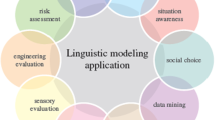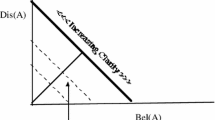Abstract
In this paper, we present a new 2-tuple linguistic representation model, i.e. Distribution Function Model (DFM), for combining imprecise qualitative information using fusion rules drawn from Dezert-Smarandache Theory (DSmT) framework. Such new approach allows to preserve the precision and efficiency of the combination of linguistic information in the case of either equidistant or unbalanced label model. Some basic operators on imprecise 2-tuple labels are presented together with their extensions for imprecise 2-tuple labels. We also give simple examples to show how precise and imprecise qualitative information can be combined for reasoning under uncertainty. It is concluded that DSmT can deal efficiently with both precise and imprecise quantitative and qualitative beliefs, which extends the scope of this theory.
Similar content being viewed by others
References
Denœux T (1999) Reasoning with imprecise belief structures. Int J Approx Reas 20:79–111 (published preliminary as Heudiasys 97/44 Technical Report)
Dezert J, Smarandache F (2004) Fusion of imprecise beliefs. In: Smarandache F, Dezert J (eds) Advances and applications of DSmT for information fusion (collected works), vol 1. American Research Press, Rehoboth.
Dezert J, Smarandache F (2008) A new probabilistic transformation of belief mass assignment. In: Proceedings of fusion 2008 international conference, Cologne, Germany, July 2008
Dubois D, Prade H (2001) Decision-theoretic foundations of qualitative possibility theory. Eur J Oper Res 128(3):459–478
Dubois D, Prade H (1993) Qualitative reasoning with imprecise probabilities. J Intell Inf Syst 2(4):319–363
Ferson S, Donald S (1998) Probability bounds analysis. In: Proceedings of international conference on probabilistic safety assessment and management (PSAM4). Springer, New York
Wang J-H, Hao JY (2006) A new version of 2-tuple fuzzy linguistic representation model for computing with words. IEEE Trans Fuzzy Syst 14(3):435–445
Wang J-H, Hao JY (2007) An approach to computing with words based on canonical characteristic values of linguistic labels. IEEE Trans Fuzzy Syst 15(4):593–603
Hájek P, Harmancová D, Verbrugge R (1995) A qualitative fuzzy possibilistic logic. Int J Approx Reas 12(1):1–19
Herrera F, Martínez L (2000) A 2-tuple fuzzy linguistic representation model for computing with words. IEEE Trans Fuzzy Syst 8(6):746–752
Herrera F, Martínez L (2001) A model based on linguistic 2-tuples for dealing with multi-granular hierarchical linguistic contexts in multi-expert decision-making. IEEE Trans Syst Man Cybern 31(2):227–234
Herrera F, Herrera-Viedma E, Martínez L (2008) A fuzzy linguistic methodology to deal with unbalanced linguistic term sets. IEEE Trans Fuzzy Syst 16(2):354–370
Li X (2007) Research on fusion method of imperfect information from multi-source and its application. PhD thesis, Huazhong University of Science and Technology, China, June 2007
Li X, Huang X, Dezert J, Smarandache F (2007) Enrichment of qualitative beliefs for reasoning under uncertainty. In: Proceedings of fusion 2007 international conference, Québec, Canada, July 2007
Kifer M, Subrahmanian VS (1991) Theory of generalized annotated logic programs and its applications. J Log Program
Parsons S (1993) Qualitative methods for reasoning under uncertainty. PhD thesis, Department of Electrical Engineering, Queen Mary and Westfield College
Parsons S, Mamdani E (1993) Qualitative Dempster-Shafer theory. In: Proceedings of the third EMACS international workshop on qualitative reasoning and decision technologies, Barcelona, Spain
Parsons S (1994) Some qualitative approaches to applying Dempster-Shafer theory. Inf Decis Technol 19:321–337
Polya G (1954) Patterns of plausible inference. Princeton University Press, Princeton
Shafer G (1976) A mathematical theory of evidence. Princeton University Press, Princeton
Smarandache F, Dezert J (eds) (2004) Advances and applications of DSmT for information fusion (collected works), vol 1. American Research Press, Rehoboth. http://www.gallup.unm.edu/~smarandache/DSmT-book1.pdf
Smarandache F, Dezert J (2005) Information fusion based on new proportional conflict redistribution rules. In: Proceedings of fusion 2005, Philadelphia, USA, July 2005
Smarandache F, Dezert J (eds) (2006) Advances and applications of DSmT for information fusion (collected works), vol 2. American Research Press, Rehoboth. http://www.gallup.unm.edu/~smarandache/DSmT-book2.pdf
Smarandache F, Dezert J (eds) (2009) Advances and applications of DSmT for information fusion (Collected works), vol 3. American Research Press, Rehoboth
Smarandache F, Dezert J (eds) (2007) Qualitative belief conditioning rules (QBCR). In: Proceedings of fusion 2007 international conference, Québec, Canada, July 2007
Smets P, Kennes R (1994) The transferable belief model. Artif Intell 66:191–243
Subrahmanian VS (1987) On the semantics of quantitative logic programs. In: Proceedings of the 4th IEEE symposium on logic programming
Walley P (1991) Statistical reasoning with imprecise probabilities. Chapman and Hall, New York
Wellman MP (1994) Some varieties of qualitative probability. In: Proceedings of the 5th international conference on information processing and the management of uncertainty (IPMU 1994), Paris, France, July 1994
Yager RR (2004) On the retranslation process in Zadeh’s paradigm of computing with words. IEEE Trans Syst Man Cybern 34(2):1184–1195
Zadeh L (1975) Concept of a linguistic variable and its application to approximate reasoning. Inf Sci 8(1):199–249
Zadeh L (1979) A theory of approximate reasoning. Mach Intell 9:149–194
Zadeh L (1996) Fuzzy logic = computing with words. IEEE Trans Fuzzy Syst 4(2):103–111
Zadeh L (1997) Towards a theory of fuzzy information granulation and its centrality in human reasoning and fuzzy logic. Fuzzy Sets Syst 19:111–127
Zadeh L (1998) Some reflections on soft computing, granular computing and their roles in the conception, design and utilization of information/intelligent systems. Soft Comput 2:23–25
Author information
Authors and Affiliations
Corresponding author
Rights and permissions
About this article
Cite this article
Li, X., Dai, X., Dezert, J. et al. Fusion of imprecise qualitative information. Appl Intell 33, 340–351 (2010). https://doi.org/10.1007/s10489-009-0170-2
Received:
Accepted:
Published:
Issue Date:
DOI: https://doi.org/10.1007/s10489-009-0170-2




